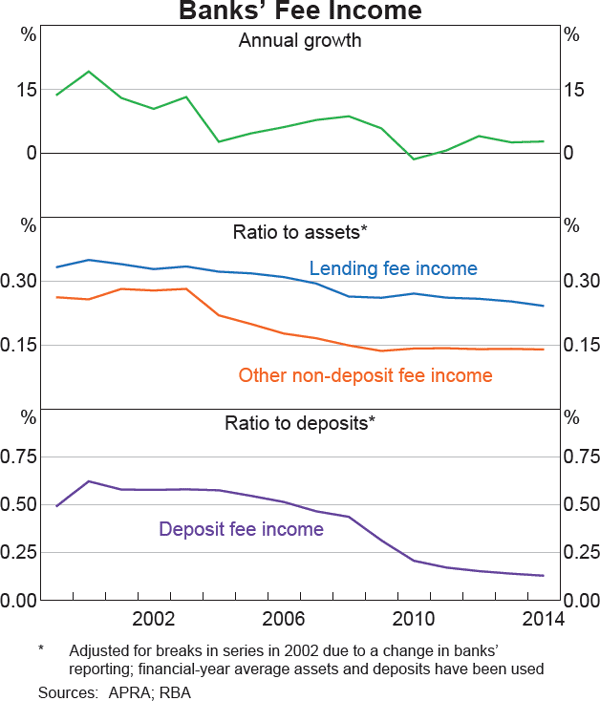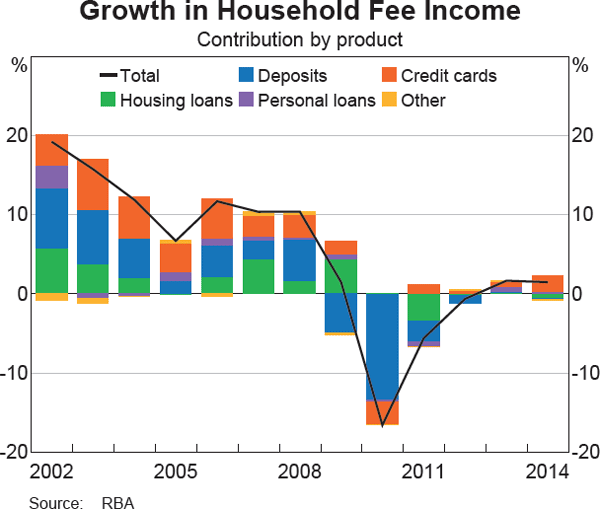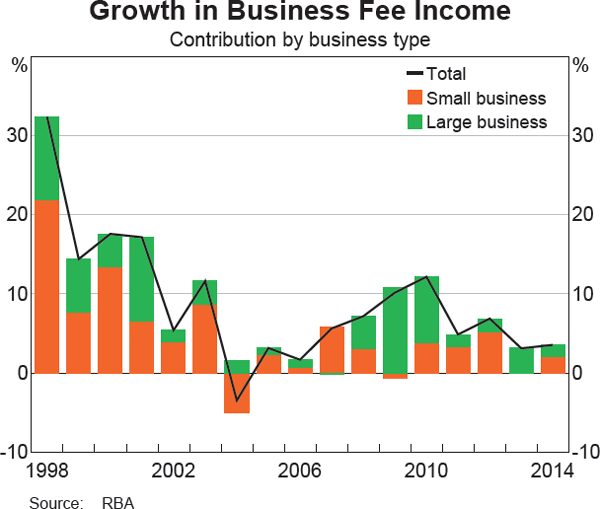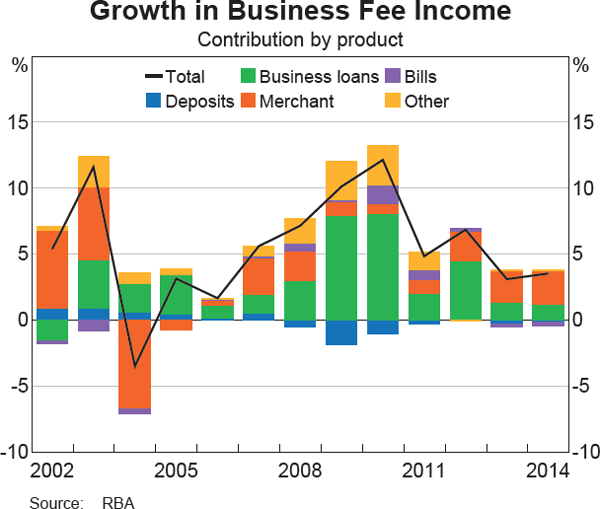Bulletin – June 2015 Payments Banking Fees in Australia
- Download the article 167KB
Abstract
The Reserve Bank has conducted a survey on bank fees each year since 1997. The results of the most recent survey suggest that banks' fee income from both households and businesses rose moderately in 2014, predominantly as a result of balance sheet growth, rather than increases in fees on loans or deposits. Overall, developments in banks' fee income followed similar patterns to 2013.
Overview
The Reserve Bank's annual bank fee survey provides information on the fees earned by banks through their Australian operations.[1] The focus of the survey is on fee income generated through the provision of loans, deposit services and payment services. The 2014 survey included 16 institutions, capturing almost 90 per cent of the Australian banking sector by balance sheet size. Fees earned from operations outside of Australia and other fee income obtained through funds management and insurance operations are excluded from the survey. This article summarises the results from the latest survey, covering banks' financial years ending in 2014.[2]
In 2014, domestic banking fee income grew by 2.8 per cent, to around $12 billion (Table 1). This reflected moderate increases in fees paid by both households and businesses, largely driven by volume growth rather than increases in unit fees. Deposit and loan fees as a ratio to outstanding values of deposits and assets were slightly lower than in the previous year (Graph 1).

| Households | Businesses | Total | ||||
|---|---|---|---|---|---|---|
| Level | Growth | Level | Growth | Level | Growth | |
| $ million | Per cent | $ million | Per cent | $ million | Per cent | |
| 2011 | 4,069 | −5.6 | 6,830 | 4.8 | 10,899 | 0.7 |
| 2012 | 4,043 | −0.6 | 7,298 | 6.9 | 11,341 | 4.1 |
| 2013 | 4,110 | 1.7 | 7,525 | 3.1 | 11,635 | 2.6 |
| 2014 | 4,171 | 1.5 | 7,791 | 3.5 | 11,962 | 2.8 |
|
Source: RBA |
||||||
Households
Banks' fee income from households grew by 1.5 per cent in 2014, the second consecutive year of positive growth after earlier notable declines (Table 2). Higher fee income reflected growth in credit card and personal lending fees, whereas fee income from housing lending and deposit accounts declined (Graph 2).
Fee income from credit cards, which represents the largest component of fee income from households, increased by 5.9 per cent in 2014. Growth in fee income from credit cards was largely volume driven, relating to an increased number of cards on issue, as well as a higher frequency of foreign exchange conversion fees being incurred by customers. Annual fees charged on credit cards were little changed in 2014 (Table 3), while income from credit card exception fees declined for the fifth consecutive year in 2014 (Graph 3). This decline reflected a reduction in the number of instances of customers exceeding their credit limit or making late payments.

The increase in fee income from personal lending was due to an increase in the number of loans issued by banks in 2014. Most of the fees earned from personal lending reflected higher instances of late/early payment fees or establishment fees associated with the increase in the volume of lending.
| 2012 | 2013 | 2014 | Annual growth 2014 |
Average annual growth 2007–13 |
|
|---|---|---|---|---|---|
| $ million | $ million | $ million | Per cent | Per cent | |
| Loans: | 2,848 | 2,904 | 2,972 | 2.3 | 2.0 |
| – Credit cards | 1,309 | 1,337 | 1,415 | 5.9 | 2.1 |
| – Housing | 1,221 | 1,226 | 1,201 | −2.1 | 2.2 |
| – Personal | 317 | 341 | 356 | 4.3 | 1.4 |
| Deposits | 1,096 | 1,102 | 1,099 | −0.3 | −9.1 |
| Other Fees | 99 | 104 | 100 | −3.5 | 2.9 |
| Total | 4,043 | 4,110 | 4,171 | 1.5 | −1.9 |
|
Source: RBA |
|||||
| 2012 | 2013 | 2014 | Change 2014 |
Average annual change 2007–13 |
|
|---|---|---|---|---|---|
| Per cent | Per cent | ||||
| Annual fees ($)(b) | |||||
| Low-rate cards | 55 | 55 | 54 | −2.2 | 2.3 |
| Standard cards | 29 | 29 | 29 | 0.0 | 0.0 |
| Standard rewards-based cards | 80 | 80 | 80 | 0.0 | 0.0 |
| Platinum rewards-based cards | 246 | 236 | 236 | 0.0 | 0.4 |
| Cash advance fees (per cent of value)(c) | |||||
| Domestic ATM | 1.8 | 1.9 | 1.9 | 3.3 | 6.6 |
| Overseas ATM | 1.8 | 1.9 | 1.9 | 3.3 | 4.5 |
| Other fees | |||||
| Foreign currency conversion fee (per cent of value) | 2.9 | 2.9 | 3.0 | 4.3 | 2.7 |
| Late payment fee ($) | 14 | 14 | 14 | 0.0 | −13.1 |
| Over-limit fee ($) | 10 | 8 | 5 | −33.3 | −20.6 |
|
(a) Simple average fees for cards with interest-free periods issued by major banks
on core products, except for the annual fee on low-rate cards, which
is based on a wider sample of banks; note that changes in the sample
affect the average fee; as at June Sources: Credit Card Issuers' Websites; RBA |
|||||

Total deposit fee income decreased slightly in 2014, following a modest increase in 2013. The decrease in fees from household deposits was broad based across most types of fees on deposit accounts. In particular, account-servicing and transaction fee income, as well as some fee income on other non-transaction accounts (e.g. break fees on term deposit accounts) declined notably. This decrease was the result of fewer customers incurring these fees rather than a decrease in the level of fees, as well as customers shifting to lower fee products. However, this was partially offset by an increase in income from more frequent occurrences of exception fees (such as overdrawn fees and dishonour fees) and foreign exchange conversion fees being charged on deposit accounts involving such transactions.
Total fee income from housing loans decreased in 2014, with all components of housing loan fee income decreasing, including exception fees. This was due to a combination of fewer instances of penalty fees being charged, and lower unit fees as a result of strong competition between banks in the home lending market. Similar to 2013, there was a decrease in fee income from housing lending despite strong growth in such lending. Several banks again reported waiving fees on this type of lending for some customers.
Businesses
Total fee income from businesses increased by 3.5 per cent in 2014 (Table 4). The increase in fee income was evident for both large and small businesses (Graph 4).

By product, the composition of the increase in fee income was very similar to the previous year (Graph 5). Growth was driven by increases in merchant service fee income and, to a lesser extent, fee income from loans. Business fee income from deposit accounts and bank bills declined over 2014.
The increase in merchant service fees was mainly attributable to an increase in utilisation of business credit cards and a slight increase in some merchant unit fees. Merchant fee growth was approximately evenly spread across both small and large businesses.
The increase in loan fee income was mainly from an increase in account-servicing and exception fees from small businesses, which was a result of higher lending volumes (including through the introduction of some new lending products). Fee income from loans to large businesses increased slightly due to a higher volume of prepayment fees (though this was mostly offset by declines in other fee income from large businesses). The increase in exception fee income from business loans was also mainly from small businesses, mostly in the form of honour fees (fees charged in association with banks honouring a payment despite insufficient funds in the holder's account).
| 2012 | 2013 | 2014 | Annual growth 2014 | Average annual growth 2007–13 | |
|---|---|---|---|---|---|
| $ million | $ million | $ million | Per cent | Per cent | |
| Deposit accounts | 623 | 603 | 590 | −2.2 | −5.3 |
| – of which: exception fees | 46 | 42 | 41 | −1.1 | na |
| Loans | 3,142 | 3,243 | 3,334 | 2.8 | 11.7 |
| – of which: exception fees | 36 | 38 | 40 | 6.5 | na |
| Merchant service fees | 2,067 | 2,238 | 2,427 | 8.4 | 5.4 |
| Bank bills | 248 | 231 | 210 | −9.2 | 21.2 |
| Other | 1,218 | 1,225 | 1,231 | 0.5 | 9.4 |
| Total | 7,298 | 7,525 | 7,791 | 3.5 | 7.3 |
| – of which: exception fees | 81 | 80 | 82 | 2.5 | na |
|
Source: RBA |
|||||

Fee income from business deposits continued to decline in 2014, with most of the decrease resulting from lower account-servicing and transaction fees, particularly for small businesses (small businesses account for the majority of business deposit fee income). The decrease was the result of a combination of lower volume growth and customers shifting to lower fee products.
Footnotes
The author is from Domestic Markets Department. [*]
The data from the survey are published in the Reserve Bank's Statistical Table C9, ‘Domestic Banking Fee Income’, and are subject to revision on the advice of the participating banks. [1]
Apart from Table 3, all data from the survey are based on individual banks' financial years, which differ between banks. [2]